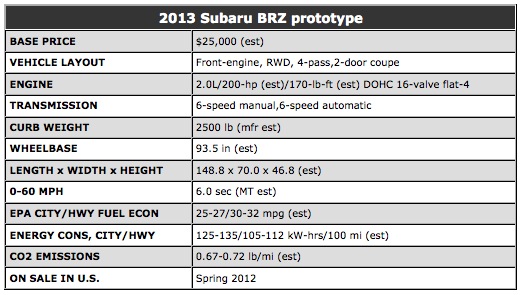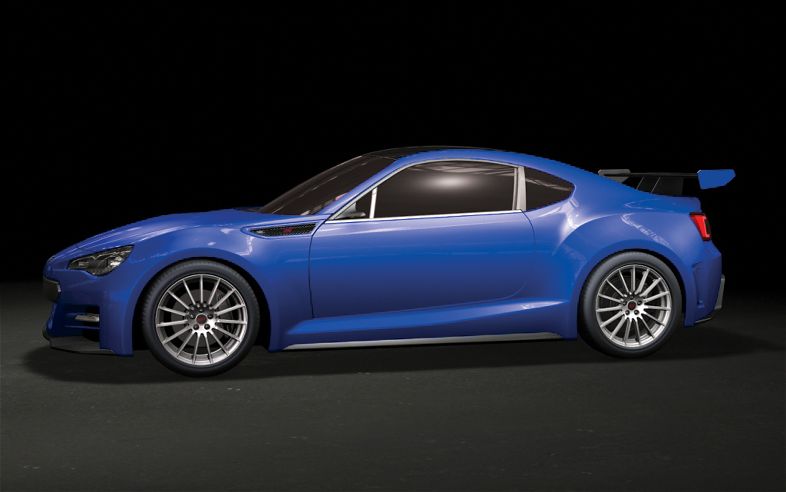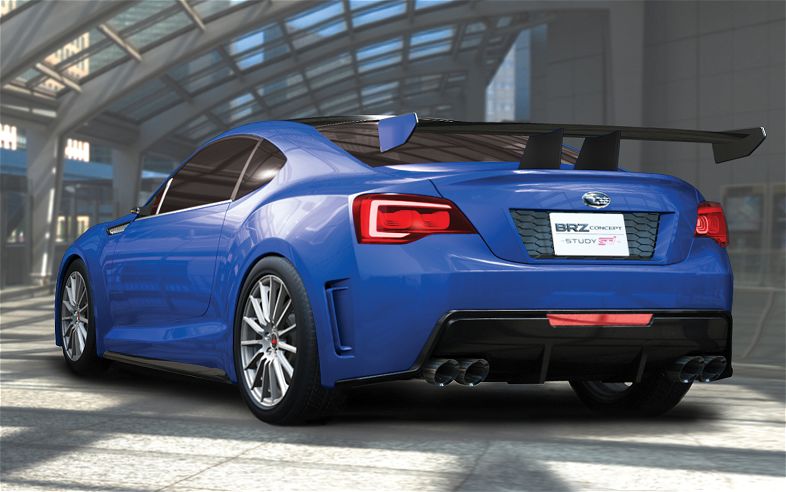First Drive: 2013 Subaru BRZ Prototype
Off the Chart: Subaru Nails it With a Nimble, Intriguing Sports Car
From the December, 2011 issue of Motor Trend
By Angus MacKenzie
Every so often in this business, you drive a car that lets you know in the first hundred yards or so that it's special -- that it's somehow greater than the sum of the numbers on its spec chart. The new Subaru BRZ is one of those cars. It's not the fastest, the most powerful, nor even the sexiest two-door coupe in the business. But if you love driving, you're going to love this Subaru.
The Subaru BRZ is the result of one of the auto industry's oddest joint ventures since Alfa Romeo and Nissan hooked up in the 1980s to produce the ARNA, a car that spectacularly combined the worst features of both: It had Alfa Romeo's suspect reliability and Nissan's boring styling and sloppy handling. This time, though, everyone looks like a winner. Subaru gets a great sports car it couldn't afford to build, and Toyota gets a great sports car, to be badged as a Scion here in the United States, that it couldn't find room to build.
Toyota did the planning and design. Subaru did the engineering, and will build both versions at its Gunma plant in Japan. Both cars will initially be identical, apart from front and rear bumper fascias, badging, and detail equipment levels. We haven't sat in the Scion yet, but we've driven the BRZ, albeit a heavily camouflaged prototype. First impressions are good. Very good.
The key to the BRZ's appeal is the unique hardware under its relatively conventional skin. This is the world's only front-engine, rear-drive sports car powered by a boxer engine. The Subaru 2.0-liter four is an all-new engine with a different block from that used in the 2012 Impreza, and features Toyota-sourced direct injection. It gets a unique FA designation within the Subaru engine family (the closely related 2012 Impreza engine is known as the FB, while the 2011 Impreza is the EJ), and though Subaru engineers were tight-lipped about the engine's output, they didn't disagree with our guess of about 200 hp and 170 lb-ft. The engine drives the rear wheels through a choice of two Aisin six-speed transmissions, one a manual, the other a conventional planetary automatic with manual actuation via steering wheel-mounted paddles. The transmission is the same one used in the Lexus IS 350, among others. Front suspension is MacPherson strut, while the rear gets a complex multilink setup. Brakes are disc all around.
Keeping the center of gravity as low as possible -- always a good thing for a sports car -- was one of the BRZ's key design goals, and Subaru's engineers have made the most of the flat-four engine's obvious advantage in this area. Compared with the 2012 Impreza's engine, the BRZ's boxer sits almost 4.8 inches lower and just over 8 inches farther back in the chassis. What that means is this: The top of the engine is roughly knee height, and the center line of the front axle is aligned with the bore center of the rear pair of cylinders.
When you slide in behind the wheel it's apparent just how low the cowl height is, even though you're sitting low in the car. Once on the road, the moment you pull the steering wheel off-center you notice how rapidly and accurately the BRZ responds to driver inputs. The weight distribution is not quite 50/50; Subaru engineers will only admit that less than 60 percent of the car's mass is over the front axle, and the chassis has been set up for mild understeer. But there's no mistaking the agility borne of low mass, slung low.
The ride is firm, but not harsh. Tellingly, the BRZ was developed on 16- and 17-inch wheels, defying the fashionable trend toward factory-fitted dubs rimmed with rubber-band-thin tires. The benefit of smaller wheels, of course, is reduced unsprung mass, and therefore better, more precise wheel control. Our tester rolled on 17s fitted with 215/45 tires that delivered good grip and gave plenty of notice approaching the limits of adhesion.
The BRZ has the same sweet-natured nimbleness as a Mazda Miata or a Porsche Boxster. That sensation is helped by the fact that, like the Miata and the original Boxster, the BRZ's engine simply cannot outdrive the chassis. It only takes a few miles along your favorite canyon road to start wishing you had 100 more horses to play with. The car stays flat through the turns, and when pushed very hard it will oversteer, but the onset is smooth and progressive. The low mass--Subaru says production cars will weigh a feathery 2500 pounds--means you can brake later for turns, carry lots of speed through them, and still nail apexes like a sharpshooter. The BRZ rewards neatness: Get it right and we bet you can hang with the more-powerful AWD WRX through the twisties.
The 2.0-liter boxer delivers healthy mid-range punch, though a little more top-end bite would be welcome. The tach is redlined at 7400 rpm, but there's little point hanging on much past 7000 as the power delivery goes flat. The engine idles quietly, but develops a pleasing muted throb, like an STI wrapped in cotton wool, when you get active with the gas pedal. Our prototype was fitted with the automatic transmission. It felt crisp and clean in regular driving, and responsive in manual mode, matching revs on the downshifts when you fanned the left-hand paddle.
The BRZ -- really, could Subaru have come up with a less evocative name for a sport coupe? -- is on some levels the most conventional car Japan's quirkiest automaker has ever built. But it opens up some intriguing possibilities for the company, especially as Subaru and Toyota are free to develop the BRZ hardware any way they like from here on in. Subaru engineers quietly concede there's more power to come from the boxer four, though they won't confirm whether a turbo is in the works. They admit the BRZ structure has been engineered from the get-go to allow for a convertible version, so you can bet we'll see a softtop model within the next few years. And, most intriguing of all, they say the platform is flexible enough to allow for a significant wheelbase stretch. A BRZ-based four-door sport sedan? Now that's an interesting idea...
How the BRZ came to be
The teaming up of Toyota and Subaru is intriguing, but not unprecedented. Back in 2008, both shared a desire to brighten their somewhat dim sports car portfolios. Toyota would take the lead in planning, designing, and bankrolling the new two-door, dubbed AS1, while Subaru offered its proven high-performance engineering and production capabilities. The companies would split sales and marketing duties.
Automotive history buffs will enjoy learning the BRZ isn't Subaru's first rear-drive vehicle. That title belongs to the 1953-'54 Fuji Heavy Industries Prototype 1 sedan, later known as the Subaru 1500. P-1 employed the first Japanese-made monocoque body and paved the way for brand icons such as the Subaru 360 and 1000. - Nate Martinez
Great Expectations
Once the Toyota/Subaru deal was sealed, engineers from both automakers made sure to agree on basic expectations. There weren't many, but each was critical in crafting the coupe you see here.
First, it had to be lightweight and fuel-efficient. Second, handling prowess, rather than all-out speed and horsepower, needed to be emphasized, with a low center of gravity. Third, there had to be enough room for four passengers and luggage space for a pair of golf bags.
Engineering a mid-engine layout would negate the 2+2 seating requirement, while an AWD system would add weight and reduce fuel economy. A twin-clutch gearbox would also add unwanted mass, plus increase cost. According to Subaru's engineers, a front-engine/rear-drive configuration with a boxer engine and a traditional gearbox duo was "ideal for [the BRZ's] vision."
Engineers were tight-lipped about exact production numbers, but they nodded in agreement when we coughed up a 3000-unit-per-year guess. That would put the BRZ in current WRX STI production territory, making it a low-volume niche car. - Nate Martinez








